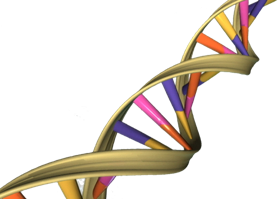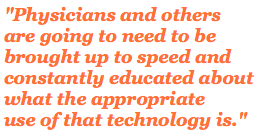Dell’s Andrew Litt on the Future of Treating Cancer with Personalized Medicine
 Chief Medical Officer of Dell Andrew Litt, MD will speak on The Future of Personalized Medicine panel at the Health 2.0 Fall Conference. In a preview of what he’ll talk about on stage next month, Andrew discusses Dell’s work with the Translational Genomics Institute to research personalized treatments for a type of children’s cancer. For more posts from the conference speaker interview series, click here.
Chief Medical Officer of Dell Andrew Litt, MD will speak on The Future of Personalized Medicine panel at the Health 2.0 Fall Conference. In a preview of what he’ll talk about on stage next month, Andrew discusses Dell’s work with the Translational Genomics Institute to research personalized treatments for a type of children’s cancer. For more posts from the conference speaker interview series, click here.
Indu Subaiya: I’m with Dr. Andrew Litt, the Chief Medical Officer at Dell, he is going to be joining us on the panel called the Future of Personalized Medicine which is the last panel of Health 2.0 coming up this fall, and we have been really interested in learning from Andy the work that they are doing with the genomic cloud project and the partnership in particular with the Translational Genomics Institute.
So Andy welcome. Why don’t we start off with you giving us a little bit of a background about this project that we are going to be learning more about?
Andrew Litt: One of the things that we are doing that’s really exciting is what we call the Genomics Cloud Project. This is a philanthropic donation, by Dell in which we’ve partnered up with an organization called the Translational Genomics Institute, which was created several years ago by many of the folks who worked at the National Institute of Health on human genome project.
That was the project that first sequenced the human genome. And their goal now is to use genomic analysis in various ways to better healthcare particularly around personalized medicine. They are working with 14 hospital research institutions across the country that are all engaged in a national cancer trial to treat a rare pediatric tumor called neuroblastoma. This cancer is difficult to treat, about 60% of the children don’t respond initially to treatment and there really isn’t a therapy for those children.
So it’s perfect kind of situation to use genomic analysis to try to figure out a better, individualized, treatment. So what TGen is doing with the 14 sites is to analyze the genome of the tumor as well as the full genome of the child, compare that with reference data sets and then identify from that where there are mutations in the tumor would make the tumor response to different therapies.
They compare the pathways affected by those mutations with those of known chemotherapy drugs that have not been previously tried, in neuroblastoma. There are hundreds of therapy drugs had been developed for other tumors, for breast cancer, for prostate cancer, lung cancer, etcetera. But the overwhelming majority have not ever been tried in neuroblastoma, and this precise mutation matching for each child helps determine which of those other drugs might work for that child.
So we have created a cancer genomics repository in the cloud we are in the process of creating a whole series of dedicated portals into this data, to allow different individuals with different backgrounds to access the data in the ways that they need to access it for their purposes. So the physician access might be different than the research scientist access, and that’s different than the patient’s access.
 And the idea here is to on the one hand promote the collaboration, because ultimately one of the things that will improve healthcare more broadly in this country is better collaboration among those who care take of patients, working together, and by having the data shared in this way and giving people access to it in real time. We really are using vast volumes of data to target therapy for that individual. It’s probably among the most use of personalized medicine that’s been out there.
And the idea here is to on the one hand promote the collaboration, because ultimately one of the things that will improve healthcare more broadly in this country is better collaboration among those who care take of patients, working together, and by having the data shared in this way and giving people access to it in real time. We really are using vast volumes of data to target therapy for that individual. It’s probably among the most use of personalized medicine that’s been out there.
Indu Subaiya: I’d imagine that there is a level of education of the physician workforce as a whole as we enter this sort of genomic medicine era, it’s about learning a whole new vocabulary, a whole new set of tools, I think it’s a very interesting time we’re in because I’d imagine many physicians were trained in an era where this was still very much science fiction.
Andrew Litt: I think that there is no question, like any evolving technology or knowledge in medicine, physicians and others are going to need to be brought up to speed and constantly educated about what the appropriate use of that technology is, no different than when we went from just doing X-rays to CTs to MRIs, or went from open surgery to laparoscopic surgery, et cetera. So I completely agree with you.
Weare just at the early, early stages of the understanding of the capabilities of this technology and even earlier on its application. Remember it’s only 10 years ago or so that the human genome was sequenced. So in the scope of medical science that’s actually fairly recently.
Indu Subaiya: And it seems to me that once your genome is sequenced in this case, particular tumor, specific data is collected that the ability to do multiple cycles of trials, in fact there is a theory, the virtual clinical trials going on and that the person themselves doesn’t have to be subject to taking this medication and that medication, these models can be run virtually, correct?
Andrew Litt: But at the same time, what will happen is that we will start to amass large amounts of data that have not been able to be acquired before, hundreds of patients potentially where we know what their genome is and we know what their clinical story is and we know how they were treated and how they responded to therapy. While there are obviously privacy issues around that the use and security of this data, the ability to learn from the continual treatment of patients is a huge opportunity as well.
Indu Subaiya: So say a little bit about the element of phenotypic data, so the data that’s not your genome type but that may come from self report or from the medical record or from other types of just — you know, patient information, what thought have you all given to how these data get integrated and analyzed along with the genomic data?
Andrew Litt: So at this point we are adding that routine clinical data to their record manually. Ultimately we envision this genomic data getting automatically linked to the patients’ electronic health record and becoming incorporated into that record. It’s really no different other than data from the patient’s lab tests or their medication list. Because ultimately the power, is to be able to combine all of this data together and then run analytics that helps physicians determine therapy when they have choices.
Right now physicians don’t know which patient would respond better to which of the different medications that could treat their condition. That’s because that data isn’t available. For example, from a completely different area, many thousands of cardiac stents are placed every year in this country and the standard treatment after stent placement is antiplatelet therapy with a drug called Plavix to reduce the chance of the stent clotting. But up to 30% of Americans of European origin have a mutation that makes it more likely that Plavix won’t work. In those patients, it might make sense to use a different drug to reduce the chance of stent thrombosis.
Indu Subaiya: Sure, and let me wrap up. We have been talking a lot about therapeutic personalization but as you move forward in this arena can we imagine either diagnostic or preventative study?
Andrew Litt: Sure, one could imagine that certain genomic mutations would place an individual at a higher risk for one form of disease or another over their lifetime, and they might benefit from different preventative measures and/or different diagnostics to prevent or discover early that disease.
For example, we already know about two mutations that make women more likely to have breast cancer in their lifetime. So a woman who has one of those mutations will receive more frequent screening than the average woman.
Indu Subaiya: Great, Andy thank you so much for taking time to update us on this, we really look forward to delving in more detail on stage, at Health 2.0 where you are going to be joined by the folks on the panel and me and others that will take a very interesting look into the future here.


 Idea for a guest post? Get in
Idea for a guest post? Get in